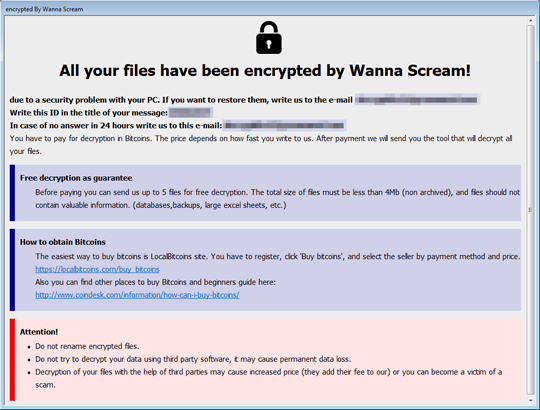Ransom.MSIL.WANNASCREAM.C
Trojan:MSIL/Filecoder.DSK!MTB (MICROSOFT); HEUR:Trojan-Ransom.MSIL.Encoder.gen (KASPERSKY)
Windows


Threat Type: Ransomware
Destructiveness: No
Encrypted: No
In the wild: Yes
OVERVIEW
Downloaded from the Internet
This Ransomware arrives on a system as a file dropped by other malware or as a file downloaded unknowingly by users when visiting malicious sites.
It connects to a website to send and receive information.
It drops files as ransom note. It avoids encrypting files with the following file extensions.
TECHNICAL DETAILS
29,696 bytes
EXE
Yes
18 Jun 2020
Displays message/message boxes, Encrypts files
Arrival Details
This Ransomware arrives on a system as a file dropped by other malware or as a file downloaded unknowingly by users when visiting malicious sites.
Installation
This Ransomware adds the following processes:
- %System%\cmd.exe /c vssadmin.exe delete shadows /all /quiet
(Note: %System% is the Windows system folder, where it usually is C:\Windows\System32 on all Windows operating system versions.)
Autostart Technique
This Ransomware drops the following file(s) in the Windows Startup folder to enable its automatic execution at every system startup:
- %User Startup%\winlogon.exe → Copy of Itself
- %User Startup%\info.hta → Detected as Ransom.MSIL.WANNASCREAM.C.note
(Note: %User Startup% is the current user's Startup folder, which is usually C:\Windows\Profiles\{user name}\Start Menu\Programs\Startup on Windows 98 and ME, C:\WINNT\Profiles\{user name}\Start Menu\Programs\Startup on Windows NT, C:\Documents and Settings\{User name}\Start Menu\Programs\Startup on Windows 2003(32-bit), XP and 2000(32-bit), or C:\Users\{user name}\AppData\Roaming\Microsoft\Windows\Start Menu\Programs\Startup on Windows Vista, 7, 8, 8.1, 2008(64-bit), 2012(64-bit), 10(64-bit).)
Backdoor Routine
This Ransomware connects to the following websites to send and receive information:
- http://recoverydata.{BLOCKED}sting.com/db
Information Theft
This Ransomware gathers the following data:
- Operating System
- CPU information
- Public IP Address
- Total Size of All Logical Drives
- Machine Name
- Volume Serial Number
- Processor ID
Ransomware Routine
This Ransomware avoids encrypting files with the following strings in their file path:
- ReadMe.txt
- info.hta
- BOOTNXT
- bootmgr
- BOOTSECT.BAK
- boot.sdi
- ReAgent.xml
- Winre.wim
- BOOTSTAT.DAT
- C:\Windows
It appends the following extension to the file name of the encrypted files:
- .[{Generated ID from Volume Serial ID or Processor ID}[decryptfile25@protonmail.com].Fob
It drops the following file(s) as ransom note:
- {Encrypted Directory}\info.hta

- {Encrypted Directory}\ReadMe.txt

It avoids encrypting files with the following file extensions:
- .Fob
SOLUTION
9.850
15.940.03
19 Jun 2020
15.941.00
20 Jun 2020
Step 1
Trend Micro Predictive Machine Learning detects and blocks malware at the first sign of its existence, before it executes on your system. When enabled, your Trend Micro product detects this malware under the following machine learning name:
- Troj.Win32.TRX.XXPE50FFF036
Step 2
Before doing any scans, Windows 7, Windows 8, Windows 8.1, and Windows 10 users must disable System Restore to allow full scanning of their computers.
Step 3
Note that not all files, folders, and registry keys and entries are installed on your computer during this malware's/spyware's/grayware's execution. This may be due to incomplete installation or other operating system conditions. If you do not find the same files/folders/registry information, please proceed to the next step.
Step 4
Restart in Safe Mode
Step 5
Search and delete these files
- %User Startup%\info.hta
- %User Startup%\winlogon.exe
- {Encrypted Directory}\info.hta
- {Encrypted Directory}\ReadMe.txt
Step 6
Restart in normal mode and scan your computer with your Trend Micro product for files detected as Ransom.MSIL.WANNASCREAM.C. If the detected files have already been cleaned, deleted, or quarantined by your Trend Micro product, no further step is required. You may opt to simply delete the quarantined files. Please check this Knowledge Base page for more information.
Step 7
Restore encrypted files from backup.
Did this description help? Tell us how we did.

